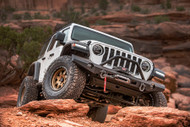Mission Impassible : Getting Unstuck with WARN and VRS Winches
4th Nov 2020
Big ruts, boggy mud, deep sand. Australia is rich with treacherous terrain waiting to halt the progress of a 4x4 vehicle.
Yet for many off-road enthusiasts, getting stuck is half the fun – and proof they are genuinely challenging both their driving skills and their vehicle's capabilities. Treads and a snatch strap will work in plenty of instances, but for the most serious off-roading – and most difficult extractions – an electric winch system is a must-have accessory. Think of it as a mechanical insurance policy and one that is especially crucial for any 4x4 driver looking to go on solo adventures.
On Upfitter, you will find two distinct winch brands: WARN and VRS.
American brand Warn has been distributed in Australia by Ateco Equipment since 1970. Warn is widely regarded as the global leader in winch systems and has long been cherished by 4x4 enthusiasts.
“They are the innovators in this field,” says Gerry Wilson, General Manager of Ateco Equipment. “And what you still see now, even after all these decades, is that if Warn comes out with a new winch model, others will soon have some form of copy. Wilson also has huge praise for Warn’s proven quality. “Ateco has been supplying Nissan with Warn winches since the 1970s, for example, and we haven’t needed to do a lot of maintenance on Warn products.
“Warn has a reputation for longevity and durability in the market because it has tens of thousands of products out there.”VRS is a relatively new brand compared with Warn. It was created in 2008 by Ateco Equipment as a 'value line range' to compete with cheaper rivals entering the winch market, complementing the Warn range that remained in a more premium price territory based on its enviable reputation.
While VRS provides an alternative for customers with lower budgets, the local brand – which also exports globally – has used Ateco’s decades of experience to develop its winch systems, while also ensuring their reliability by testing them extensively in Australia’s challenging Outback.
As Wilson says: “You can only gain credibility and durability for your products by testing in a real-world environment, not some lab.” Every VRS winch comes with the highest Ingress Protection (IP) Rating: IP68. The ‘6’ means the product is not susceptible to dust ingress, while the ‘8’ digit signifies the product can withstand long-term immersion in water beyond a metre deep (up to a specified pressure).
With such an extensive range of winch systems available – even just taking Warn and VRS into account – buyers are spoilt for choice. This includes determining the pulling capacity they want. The VRS winches found on Upfitter are rated at either 9500Ibs / 4300kg (the industry standard) or 12,500Ibs / 5670kg. Upfitter’s Warn winches range between 8000lbs / 3629kg and 12,000Ibs / 5443kg.
Gerry says that while pulling capacity as well as line speed were two key measurements buyers would focus on, the biggest, fastest or most powerful system isn’t necessarily best for every customer. “It’s true a faster line speed can help pop you out quicker from a bogged situation, but it’s a trade-off. The more grunt, or more pulling capacity you have, this is going to slow the line speed as the motor needs a higher gear ratio [to ensure it’s not overworking].
“And in really boggy situations, you’re just pushing mud and not popping out – and these motor winches aren’t designed to run forever. So, unless you’ve got capacity in the car’s alternator to keep the voltage up for the battery while you’re winching, the amperage increases – and higher amperage means heat, you start to get smoke, and suddenly the winch is dead. “So, it’s important for buyers to match the winch system to their vehicle.
“Something else to note is that the only reason you have to use a winch is because you’ve lost traction to your wheels,” continues Gerry. “In most cases [of getting stuck], you won’t pull the winch all the way out to its full rope length, which is about 100ft, or 30 metres. “It’s probably in the vicinity of 3-4 metres before the vehicle has regained traction and you’re off again. So, you’re not winching for that long.”
For many years, a winch’s rope was made of wire. But in the mid-1990s, maritime-inspired synthetic rope emerged as an alternative and has since become highly popular. Ateco Equipment says where the sales ratio once equalled one synthetic-rope winch sold for every steel-cable winch, the opposite applies today. “When it comes to synthetic versus wire rope, there are pros and cons to each and it’s very much a personal choice,” says Gerry.
Advantages of wire rope include greater durability, reduced maintenance, a lower cost typically, and it's ideal for particularly abrasive terrain and UV exposure is less of an issue than synthetic rope too.
In synthetic rope’s favour: it’s not susceptible to kinks like steel cable (though knots need to be avoided), it’s lighter and more flexible than wire, and it’s theoretically safer in the event of a snapped rope, as it will drop to the ground rather than become a potentially dangerous projectile like a steel cable (though a winch damper should always be used, regardless of rope type). The lower weight of synthetic rope – a distinctive blue on VRS winches to match the brand’s corporate colour – can be particularly important for weight distribution.
Weighing on average 9kg less than the equivalent steel cable, it can help some owners avoid making their vehicles illegal by exceeding the front-axle weight limit. The additional bonus is that this places a little less burden on the vehicle’s front suspension.
Warn and VRS winches are offered with both types of rope.
Image Credits : Top - Courtesy of WARN Industries. Bottom - Courtesy of VRS / Ateco Equipment.




